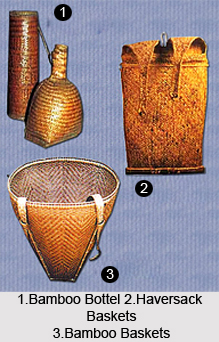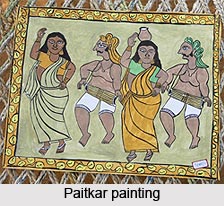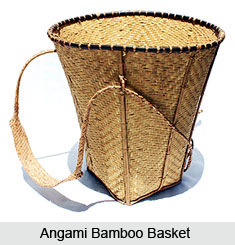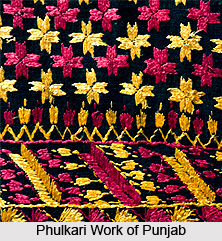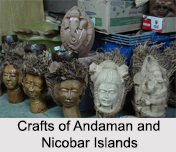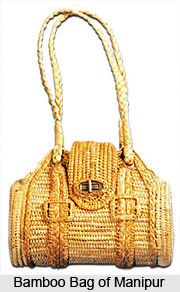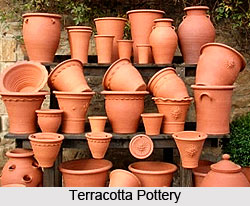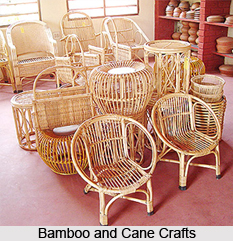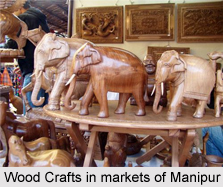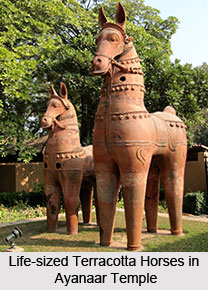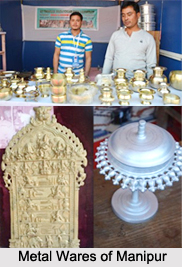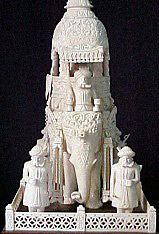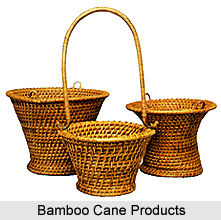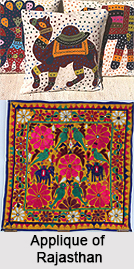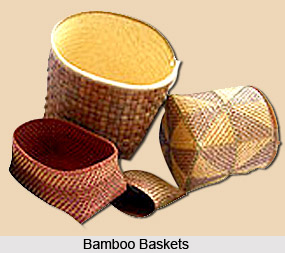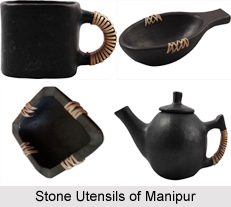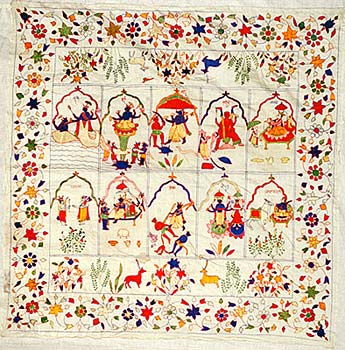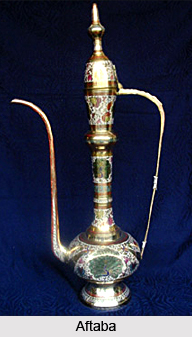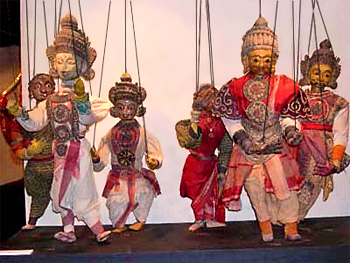The Naga tribes of Manipur have similar textile technology and culture to that of the Naga tribes of Nagaland, though there are differences in designs. One of the well known Naga tribes in Manipur, the Rongmei Nagas, often called the Kabuis, bear similarity with the Zeme and Liamgmei Nagas of Assam and Nagaland, together known as the Zeliangrong Nagas. Like other Naga tribes, the Rongmeis used to grow short staple length cotton, spinning them with a drop spindle or spinning wheel and weaving fabrics with the Loins loom. However, their ginning method is better than their cousins", which they are believed to have learnt from the Mizos and Kukis. They also used nettle fibre as raw material for their textile products. Their traditional dresses, which were simple yet beautiful, have undergone considerable changes. Like their cousins, they also switched over to mill made yarns.
The traditional costume of the Rongmeis was ideally described by Dr. R. Brown, who was political Agent of Manipur. He stated in his official report that the dress of the male Kabuis was scanty; those living in the jungles only wore a small square piece of cloth in the front, hanging below and covering the privates, confined to the waist by a string. In the valley of Manipur, more decent costume was adopted - either a kilt-like piece of cloth round the waist or a short dhoti put on in Bengali fashion. The only other article of clothing worn by the men was a thick sheet of cotton cloth, when the weather was cold. The Kabui women wore a piece of cotton cloth of thick texture, put on the same way as the Meithei Phanek, reaching little below the knee. This garment is confined round the waist by a coloured scarf with fringed ends. The colour for ordinary wear is usually of a muddy hue with coloured stripes of various widths, the blue with red stripes being the favourite. Over the shoulder is worn a scarf-shaped piece of cloth, generally blue with a border and fringe of another colour. It may be interesting to note that the Phanek or long petticoat is fastened under the right breast by the Kabui women while a Meithei woman fastens it under the left breast.
On gala days or festive occasions, the ordinary plain fashions are supplanted by elaborate costumes, the men wearing coats embroidered with a fringe of green beetles" wings and a head dress ornamented with feathers of toucan or horn bill, along with silk dhotis that are usually procured from the Loi villages. The girls wear petticoats, often red, black and white stripes, with small geometrical patterns worked in that enhance the value of the cloth. The Loin cloth worn by the men are dark in colour, with white lines about 2 to 3 centimetres wide, with the centre also being white.
The Maram Naga tribe lives close to the Manipur-Nagaland border almost on the Imphal-Kohima national highway. They are considered one of the quasi-Angami tribes, given their similarity with the Angami tribe. The textile technology adopted is similar to those of Angami Nagas. The ordinary dress of a Maram Naga consists of a short black cotton kilt about 45 centimetres deep, ornamented by three or four rows of white cowries, or in the degenerated days, white trouser buttons. However, it may be noted that no man put these rows of cowries on his kilt until he had slain two men. A white cotton rug thrown over the shoulders completes the costume. The chiefs or the men who had erected a stone were privileged to wear a dark blue cloth embroidered with red yarn, the designs of which are normally animal figures or stone conventional geometrical designs. The Marams are often seen wearing the Angami dresses as well. The influence of Meithei style on their costume is also noticeable.
The Mao Nagas are another quasi-Angami tribe who also inhabit the Manipur-Nagaland border. Again there is a considerable influence of the Angami designs and styles in their textiles. The Mao tribe is further subdivided into various sub-tribes, such as Merni and Paomata, who also maintain their separate identity though textiles and dresses are more or less identical. The ordinary dress of a Mao Naga also comprises a black cotton kilt about 45 centimetres deep, ornamented by three or four rows of white cowries or in the degenerated days, white trouser buttons. It is again believed these rows of cowries were permitted only to those who had slain at least two heads. A dirty white rug thrown over the shoulders completes the costume. Headmen or "Lung Chingbas" are the men who had erected a stone and privileged to wear a dark blue cloth embroidered with red-threaded quaint figures of animals. Girls wear two garments, one of which may be regarded as worn for effect as it consists of a plain square of cloth, often dark blue or black with red border, hung round the neck over the bosom. The kilt descends to the knee which it barely covers. Older women wrap themselves up in a white rug which is thrown apparently without any method. Some ladies also wear their traditional petticoats. Many clothes are found with small geometrical patterns that are supposed to be signature or trade mark of magical origin. Like any other tribes of the region, the Mao tribe also uses shawls having typical designs of their own that can be identified easily from others, although influence of the Angami designs cannot be ruled out. The shawls were used to be of stout cotton earlier but in the contemporary scenario of scientific exploitation, they have been switched over to mill made synthetic wool. The shawls consist of four pieces of cloth woven in their wonderful Loins loom and neatly stitched together. One of the Mao designs is a shawl with black and red stripes arranged systematically. The two edge breadths have stripes about 2 to 3 centimetres wide while the centre breadth has the black stripes with faint white stripes and red stripes above about 10 centimetres wide. They also weave and wear shawls having designs exactly similar to those of the Angamis.
The Tangkhul Naga tribe are found settled in the Ukhrul district of Manipur and considered to be one of the exceptional tribes among the Nagas in many ways. It is the only tribe to have features of both Mongoloid and Aryans which makes them one of the most handsome people of the east. Among the Naga tribes settled in Manipur and Nagaland, they stand second in respect of literacy after Ao and third in respect of population after Konyaks and Angamis. Traditionally, the Tangkhuls are divided into eight regional divisions: North - Raphei, Northeast - Somra, Southeast - Kaikhang, East - Ram, South - Kamao, West - Kharao, Southwest - Kharei and Northwest - Kharas Raora. People of each division are believed to be experts in a particular skill, the product of which is consumed by the entire tribe. Therefore, they have had professional management in their tradition. The Kharaos are the expert weavers and even today they produce the bulk of cloth used by the Tangkhuls. They use technology almost identical to all other Naga tribes and that has undergone identical changes. But the design of the fabrics, whether shawls, wrappers or petticoats, are brilliant. Dull or bright red shawls embroidered with white threads are one of the popular Tangkhul shawls of Manipur.
Related Articles:
Manipur
Textiles of Manipur
Crafts of Manipur
Tribes of Manipur
Indian Costumes
Weaving and Dyeing Craft
Naga Tribes
Kabui Tribe, Manipur
Tangkhul Tribe, Manipur
Maram Nagas
